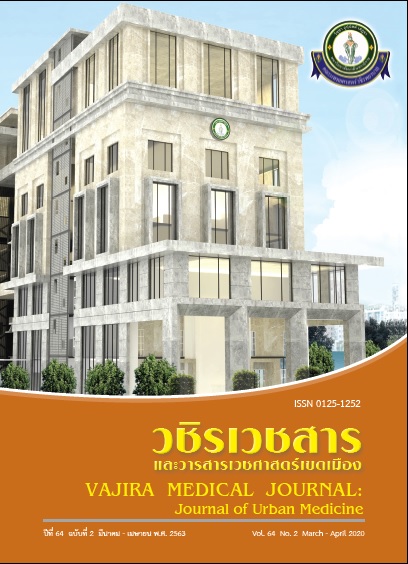Prevalence of Vitamin D and Calcium Deficiency among Postmenopausal Women Base on National Comprehensive Cancer Network in Urban Area
Main Article Content
Abstract
Background: Vitamin D is important in the absorption of calcium in the gastrointestinal tract. It plays role in promoting the accumulation of calcium in the bones and muscles. Major resources of vitamin D are in the diet, such as liver, fish, salmon, and eel. Vitamin D-synthesis through the skin is activated by sunlight. Even though Thailand is located near the equator, between latitudes 5 ° 40 ‘N - 20 ° 30’ N sunlight, there is a report about the situation of vitamin D deficiency in the country. NCCN recommended that patients receiving aromatase inhibitors get vitamin D and calcium supplements. These results provided the data of vitamin D and calcium levels in Thai postmenopausal patients. The prescription for vitamin D and calcium supplements should be given. in those patients who received aromatase inhibitor.
Objective: To study the prevalence of vitamin D deficiency and calcium in postmenopausal women in the urban areas.
Methods: A cross-sectional, descriptive study was conducted in the postmenopausal patients without underlying diseases related to gastrointestinal absorption in Vajira Hospital. The information about the underlying disease, age, sex, menopausal period, serum calcium, and serum 25 – hydroxyvitamin D was collected and analyzed by statistical software (SPSS version 18).
Outcome: Postmenopausal women according to the National Comprehensive Cancer Network criteria in the urban areas have a low level of serum calcium and serum 25-hydroxyvitamin D. The supplements of Vitamin D and calcium in these patients are necessary.
Results: 107 cases of postmenopausal women were recruited. They are postmenopausal women aged 52-90 years old. The mean serum 25 –hydroxyvitamin D level among the postmenopausal women was 17.05 ng/mL and mean serum calcium level was 8.4 mg/dL. The prevalence of vitamin D deficiency and calcium deficiency in postmenopausal women was 93 percent and 63 percent, respectively.
Conclusion: There is a high prevalence of vitamin D deficiency and calcium deficiency among postmenopausal urban women. This study supports the guideline of the National Comprehensive Cancer Network to supplement calcium and vitamin D for all patients who received aromatase inhibitor.
Downloads
Article Details
References
Tsai KS, Wahner HW, Offord KP, et al. Effect of aging on vitamin D stores and bone density in women. Calcif Tissue Int 1987; 40:241.
Webb AR, Kline L, Holick MF. Influence of season and latitude on the cutaneous synthesis of vitamin D3: exposure to winter sunlight in Boston and Edmonton will not promote vitamin D3 synthesis in human skin. J Clin Endocrinol Metab 1988; 67:373.
MacLaughlin J, Holick MF. Aging decreases the capacity of human skin to produce vitamin D3. J Clin Invest 1985; 76:1536.
Soontrapa Sk, Soontrapa Sp, Pongchaiyakul C, Somboonporn C, Somboonporn W, Chailurkit L. Prevalence of hypovitaminosis D in eldery women living in urban area of Khon Kaen province, Thailand. J Med Assoc Thai 2001; 84(Suppl 2): S534-S541.
Soontrapa Sp, Soontrapa Sk, Chailurkit L. The prevalence and the calcidiol levels of vitamin D deficiency in the elderly Thai women in municipality of Khon Kaen Province, Thailand.Srinagarind Med J 2002; 17(4):219-26.
NCCN: Menopause Definition Required When Considering Adjuvant Aromatase-Inhibitor Therapy in Breast Cancer. Susman, Ed Oncology Times: April 25th, 2005 - Volume 27 - Issue 8 - p 54


